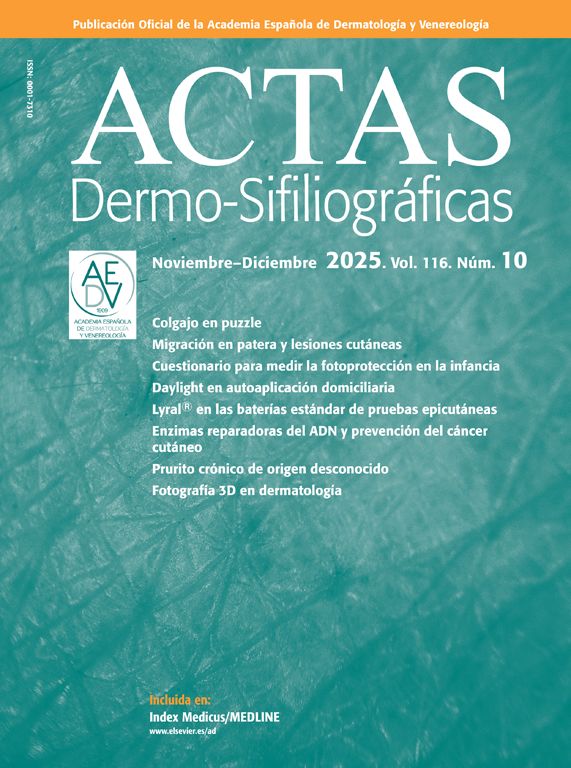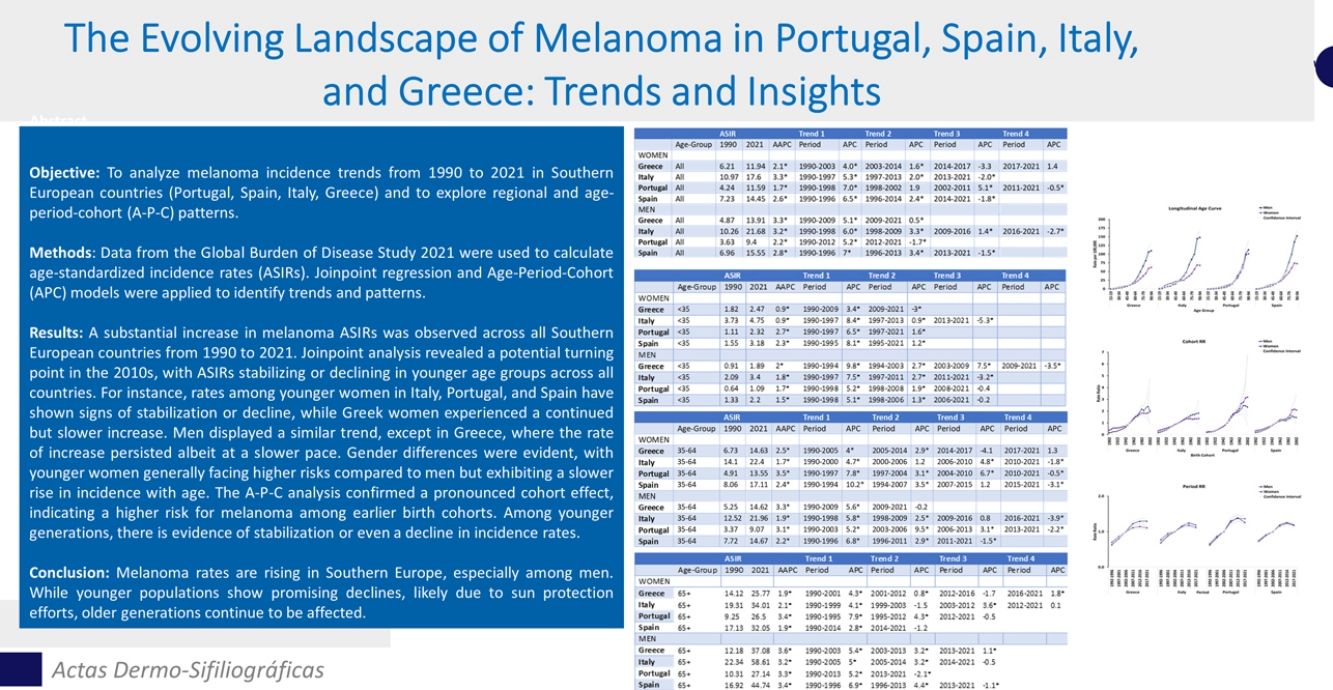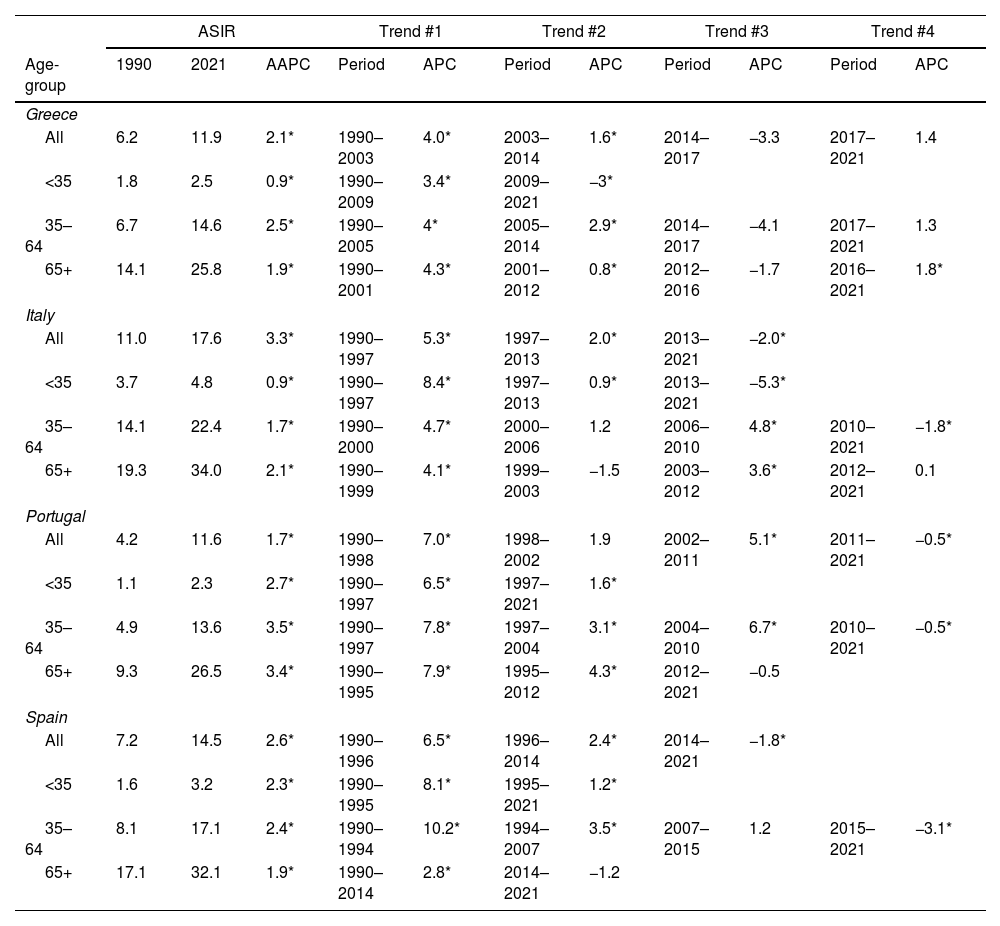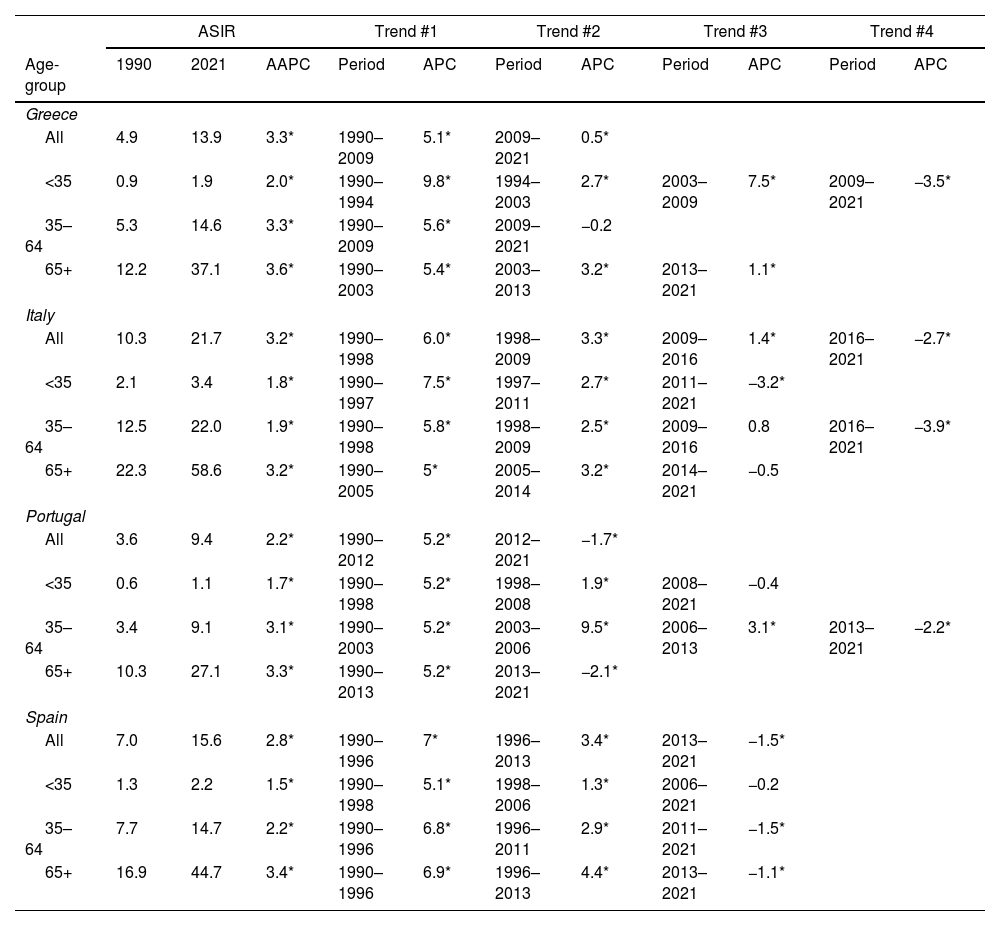To study melanoma incidence trends from 1990 to 2021 in Southern European countries—Portugal, Spain, Italy, Greece—and explore regional and age-period-cohort (A-P-C) patterns.
MethodsData from the Global Burden of Disease Study 2021 were used to calculate age-standardized incidence rates (ASIRs). Joinpoint regression and age-period cohort (A-P-C) models were applied to identify trends and patterns.
ResultsA substantial increase in melanoma ASIRs was observed across all Southern European countries from 1990 to 2021. Joinpoint analysis revealed a potential turning point in the 2010s, with ASIRs stabilizing or declining in younger age groups across all countries. For instance, rates among younger women in Italy, Portugal, and Spain have shown signs of stabilization or decline, while Greek women experienced a continued but slower increase. Men exhibited a similar trend, except for Greece, where the increase rate persisted albeit at a slower pace. Gender differences were evident, with younger women generally facing higher risks vs men but exhibiting a slower rise in incidence with age.
The A-P-C analysis confirmed a pronounced cohort effect, indicating a higher risk for melanoma among earlier birth cohorts. Among younger generations, there is evidence of stabilization or even a decline in incidence rates.
ConclusionMelanoma rates are rising in Southern Europe, especially among men. While younger populations show promising declines, likely due to sun protection efforts, older generations continue to be affected. Addressing regional disparities and sustaining these positive trends requires ongoing efforts and comprehensive prevention strategies.
Analizar las tendencias en la incidencia del melanoma entre 1990 y 2021 en los países del sur de Europa (Portugal, España, Italia, Grecia) y los patrones regionales y de edad-período-cohorte (E-P-C).
MétodosSe utilizaron datos del Global Burden of Disease Study 2021 para calcular las tasas de incidencia estandarizadas por edad (ASIR). Se aplicaron modelos de regresión de cambio de tendencia y de E-P-C para identificar tendencias y patrones.
ResultadosSe observó un aumento sustancial de las ASIR de melanoma en todos los países del sur de Europa entre 1990 y 2021. El análisis de tendencia reveló un posible punto de inflexión en la década de 2010, con una estabilización o disminución de las ASIR en los grupos de edad más jóvenes en todos los países. Las tasas entre las mujeres más jóvenes en Italia, Portugal y España han mostrado signos de estabilización o disminución, mientras que las mujeres griegas experimentaron un aumento continuo pero más lento. Los hombres mostraron una tendencia similar, excepto en Grecia, donde la tasa de aumento persistió, aunque a un ritmo más lento. Las diferencias de género fueron evidentes: las mujeres más jóvenes generalmente presentan un riesgo mayor en comparación con los hombres, pero muestran un aumento más lento en la incidencia con la edad.
El análisis E-P-C confirmó un efecto de cohorte pronunciado, lo que indica un mayor riesgo de melanoma entre las cohortes de nacimiento anteriores. Entre las generaciones más jóvenes hay evidencia de estabilización, o incluso una disminución en las tasas de incidencia.
ConclusiónLas tasas de melanoma están aumentando en el sur de Europa, especialmente entre los hombres. Si bien las poblaciones más jóvenes muestran disminuciones prometedoras, probablemente debido a los esfuerzos de protección solar, las generaciones mayores continúan viéndose afectadas. Abordar las disparidades regionales y mantener estas tendencias positivas requiere esfuerzos continuos y estrategias de prevención integrales.
Melanoma, the deadliest form of skin cancer, poses a significant and growing global health threat, particularly for fair-skinned populations.1,2 With over 331,000 new cases and 58,000 deaths reported worldwide in 2022,3 the burden of melanoma far exceeds that of other skin cancers.4 This alarming trend is primarily driven by increased exposure to ultraviolet (UV) radiation from sources such as sunbathing and indoor tanning.5
Historically, Caucasian populations have experienced a dramatic rise in melanoma incidence due to birth cohort effects, which refers to differences in risk among people born in different years. However, encouraging trends have emerged in regions such as Oceania, North America, and parts of Europe, where melanoma rates have stabilized or declined, especially among younger age groups.6 These positive changes are likely attributed to effective public health campaigns promoting sun protection.
Europe exhibits substantial regional disparities in melanoma incidence. While northwestern countries witnessed a sharp increase until the 1980s followed by stabilization or decline, particularly in the 1930–1940 birth cohort,7 Southern Europe continue to grapple with rising rates. This concerning trend in countries such as Spain and Italy is associated with sunny climates, genetic factors, and lifestyle influences.8–10 Nevertheless, exceptions to this pattern exist. For instance, Catalonia reported a decline in melanoma incidence among young adults during the early 2000s,11 and similar trends were observed in Emilia-Romagna (Italy) among women born after 1961.12 A recent Italian study further supports these findings, indicating a shift in melanoma risk starting with individuals born in the 1970s.10
To enhance our understanding of melanoma incidence trends in Southern Europe, we conducted a comprehensive study examining data from Portugal, Spain, Italy, and Greece from 1990 to 2021. Our research aims to characterize the overall melanoma incidence trajectory in these countries and explore the impact of the effects of the age-period-cohort analysis on these patterns. Age effects capture changes in melanoma risk associated with ageing, period effects reflect changes occurring at specific points in time (e.g., due to public health interventions), and cohort effects represent differences between people born in different years.
MethodsData sourcesMelanoma incidence and corresponding population data for Portugal, Spain, Italy, and Greece from 1990 to 2021 were retrieved from the Global Health Data Exchange (GHDx) platform, a resource of the Institute for Health Metrics and Evaluation (IHME) contributing to the Global Burden of Disease (GBD) Study 2021 (http://ghdx.healthdata.org/gbd-results-tool, accessed 21.7.24).13 As outlined in previous GBD reports,2,14 the study draws on data from vital registration systems, disease registries, and literature search from reputable databases like national cancer registries and Cancer Incidence in Five Continents. These sources are recognized for their reliability and are regularly updated to ensure accurate cancer estimates. Melanoma cases were identified using the International Classification of Diseases (ICD) codes: ICD-10 (C43-C43.9, Z85.82-Z85.828) and ICD-9 (172–172.9). This coding scheme is consistent with that used in previous studies using the same database.2,8 Data were further stratified by age and sex to enable comprehensive analysis by country.
Statistical analysisWe estimated age-standardized incidence rates (ASIRs) stratified by sex and age groups: <35 years, 35–64 years, >64 years, and all ages combined. This standardization—calculated using the direct method with the 2013 European Standard Population15—adjusts for differences in age distribution across populations, ensuring valid comparisons.
We used the Joinpoint Regression Program (version 5.2.0.0) from the National Cancer Institute (https://surveillance.cancer.gov/joinpoint/) to analyze trends. This programme identifies potential turning points (joinpoints) in data and calculates the annual percent change (APC) for each resulting trend segment. It also determines the average annual percent change (AAPC) for the entire study period (1990–2021). Additionally, we employed the “pairwise comparison” option to assess if trends differed significantly between men and women. Statistically significant trends (p<0.05) are reported as “increases” or “decreases”; non-significant trends are described as “stable” or showing “no change.” All reported rates are presented per 100,000 individuals, and the male-to-female ratio was calculated.
To further understand the drivers of observed trends, we implemented an age-period cohort (A-P-C) model. This model distinguishes the independent effects of age at diagnosis, calendar period of diagnosis, and birth cohort on melanoma incidence. Due to potential rate instability, individuals younger than 15 years and older than 84 years were excluded from the analysis. We categorized data into 6 5-year periods (1992–1996 to 2017–2021), 16 5-year age groups (15–19 to 90–94 years), and 21 birth cohorts (1902–2002) based on the central year of birth. Age-specific incidence rate matrices for each age group and period were created using the National Cancer Institute's A-P-C software suite (https://analysistools.cancer.gov/apc/). Key parameters estimated by the model include longitudinal age-specific rates, and rate ratios (RRs) for period and cohort effects relative to the reference categories (central age group, calendar period, and birth cohort). Statistical significance was assessed using the Wald Chi-square test (α=0.05).
Ethical considerationsThis study utilized anonymized data from publicly available sources, aggregated by age group. Since data did not contain any personal identifiers and was publicly available, informed consent from patients was deemed unnecessary. This approach fully complied with the Guidelines for Accurate and Transparent Health Estimates Reporting (GATHER).16
ResultsTables 1 and 2 present ASIRs of melanoma for Greece, Italy, Portugal, and Spain stratified by sex and age group. ASIRs increased consistently across all countries, age groups, and sexes from 1990 to 2021. However, the rate of increase varied substantially.
Trends in age-standardized incidence rates (ASIR) of melanoma in women across Greece, Italy, Portugal, and Spain (1990–2021).
| ASIR | Trend #1 | Trend #2 | Trend #3 | Trend #4 | |||||||
|---|---|---|---|---|---|---|---|---|---|---|---|
| Age-group | 1990 | 2021 | AAPC | Period | APC | Period | APC | Period | APC | Period | APC |
| Greece | |||||||||||
| All | 6.2 | 11.9 | 2.1* | 1990–2003 | 4.0* | 2003–2014 | 1.6* | 2014–2017 | −3.3 | 2017–2021 | 1.4 |
| <35 | 1.8 | 2.5 | 0.9* | 1990–2009 | 3.4* | 2009–2021 | −3* | ||||
| 35–64 | 6.7 | 14.6 | 2.5* | 1990–2005 | 4* | 2005–2014 | 2.9* | 2014–2017 | −4.1 | 2017–2021 | 1.3 |
| 65+ | 14.1 | 25.8 | 1.9* | 1990–2001 | 4.3* | 2001–2012 | 0.8* | 2012–2016 | −1.7 | 2016–2021 | 1.8* |
| Italy | |||||||||||
| All | 11.0 | 17.6 | 3.3* | 1990–1997 | 5.3* | 1997–2013 | 2.0* | 2013–2021 | −2.0* | ||
| <35 | 3.7 | 4.8 | 0.9* | 1990–1997 | 8.4* | 1997–2013 | 0.9* | 2013–2021 | −5.3* | ||
| 35–64 | 14.1 | 22.4 | 1.7* | 1990–2000 | 4.7* | 2000–2006 | 1.2 | 2006–2010 | 4.8* | 2010–2021 | −1.8* |
| 65+ | 19.3 | 34.0 | 2.1* | 1990–1999 | 4.1* | 1999–2003 | −1.5 | 2003–2012 | 3.6* | 2012–2021 | 0.1 |
| Portugal | |||||||||||
| All | 4.2 | 11.6 | 1.7* | 1990–1998 | 7.0* | 1998–2002 | 1.9 | 2002–2011 | 5.1* | 2011–2021 | −0.5* |
| <35 | 1.1 | 2.3 | 2.7* | 1990–1997 | 6.5* | 1997–2021 | 1.6* | ||||
| 35–64 | 4.9 | 13.6 | 3.5* | 1990–1997 | 7.8* | 1997–2004 | 3.1* | 2004–2010 | 6.7* | 2010–2021 | −0.5* |
| 65+ | 9.3 | 26.5 | 3.4* | 1990–1995 | 7.9* | 1995–2012 | 4.3* | 2012–2021 | −0.5 | ||
| Spain | |||||||||||
| All | 7.2 | 14.5 | 2.6* | 1990–1996 | 6.5* | 1996–2014 | 2.4* | 2014–2021 | −1.8* | ||
| <35 | 1.6 | 3.2 | 2.3* | 1990–1995 | 8.1* | 1995–2021 | 1.2* | ||||
| 35–64 | 8.1 | 17.1 | 2.4* | 1990–1994 | 10.2* | 1994–2007 | 3.5* | 2007–2015 | 1.2 | 2015–2021 | −3.1* |
| 65+ | 17.1 | 32.1 | 1.9* | 1990–2014 | 2.8* | 2014–2021 | −1.2 | ||||
Trends in age-standardized incidence rates (ASIR) of melanoma in men across Greece, Italy, Portugal, and Spain (1990–2021).
| ASIR | Trend #1 | Trend #2 | Trend #3 | Trend #4 | |||||||
|---|---|---|---|---|---|---|---|---|---|---|---|
| Age-group | 1990 | 2021 | AAPC | Period | APC | Period | APC | Period | APC | Period | APC |
| Greece | |||||||||||
| All | 4.9 | 13.9 | 3.3* | 1990–2009 | 5.1* | 2009–2021 | 0.5* | ||||
| <35 | 0.9 | 1.9 | 2.0* | 1990–1994 | 9.8* | 1994–2003 | 2.7* | 2003–2009 | 7.5* | 2009–2021 | −3.5* |
| 35–64 | 5.3 | 14.6 | 3.3* | 1990–2009 | 5.6* | 2009–2021 | −0.2 | ||||
| 65+ | 12.2 | 37.1 | 3.6* | 1990–2003 | 5.4* | 2003–2013 | 3.2* | 2013–2021 | 1.1* | ||
| Italy | |||||||||||
| All | 10.3 | 21.7 | 3.2* | 1990–1998 | 6.0* | 1998–2009 | 3.3* | 2009–2016 | 1.4* | 2016–2021 | −2.7* |
| <35 | 2.1 | 3.4 | 1.8* | 1990–1997 | 7.5* | 1997–2011 | 2.7* | 2011–2021 | −3.2* | ||
| 35–64 | 12.5 | 22.0 | 1.9* | 1990–1998 | 5.8* | 1998–2009 | 2.5* | 2009–2016 | 0.8 | 2016–2021 | −3.9* |
| 65+ | 22.3 | 58.6 | 3.2* | 1990–2005 | 5* | 2005–2014 | 3.2* | 2014–2021 | −0.5 | ||
| Portugal | |||||||||||
| All | 3.6 | 9.4 | 2.2* | 1990–2012 | 5.2* | 2012–2021 | −1.7* | ||||
| <35 | 0.6 | 1.1 | 1.7* | 1990–1998 | 5.2* | 1998–2008 | 1.9* | 2008–2021 | −0.4 | ||
| 35–64 | 3.4 | 9.1 | 3.1* | 1990–2003 | 5.2* | 2003–2006 | 9.5* | 2006–2013 | 3.1* | 2013–2021 | −2.2* |
| 65+ | 10.3 | 27.1 | 3.3* | 1990–2013 | 5.2* | 2013–2021 | −2.1* | ||||
| Spain | |||||||||||
| All | 7.0 | 15.6 | 2.8* | 1990–1996 | 7* | 1996–2013 | 3.4* | 2013–2021 | −1.5* | ||
| <35 | 1.3 | 2.2 | 1.5* | 1990–1998 | 5.1* | 1998–2006 | 1.3* | 2006–2021 | −0.2 | ||
| 35–64 | 7.7 | 14.7 | 2.2* | 1990–1996 | 6.8* | 1996–2011 | 2.9* | 2011–2021 | −1.5* | ||
| 65+ | 16.9 | 44.7 | 3.4* | 1990–1996 | 6.9* | 1996–2013 | 4.4* | 2013–2021 | −1.1* | ||
Portugal experienced the slowest overall increase, with women showing a 1.7% annual rise and men a 2.2% increase. Italy exhibited the most rapid growth, with women's rates increasing by 3.3% annually and men's by 3.2%. While melanoma incidence rose significantly overall, particularly among older age groups, the joinpoint analysis revealed more complex trends throughout time.
For women of all ages, ASIRs exhibited a noticeable shift around the early 2010s. Following an initial increase, rates stabilized in Greece but declined in Italy, Portugal, and Spain. A similar trend was observed for men, except for Greece, where rates continued to rise, albeit at a slower pace. Among individuals younger than 35 years, ASIRs changed around the late 2000s to early 2010s. Rates initially rose but then slowed for Portuguese and Spanish women. For Portuguese and Spanish men, rates stabilized, while both sexes in Greece and Italy saw a decrease. In the 35–64 age group, ASIRs—which had been increasing—began to stabilize in Greece during the 2010s. Conversely, rates declined for both sexes in Italy, Portugal, and Spain. For those aged 65 and older, ASIRs also shifted around the 2010s. Rates stabilized among Italian, Portuguese, and Spanish women, as well as Italian men. However, Portuguese and Spanish men experienced declines, while Greek men showed a marked increase. Greek women continued to see a slower rate of increase.
Fig. 1 shows the longitudinal age curves for melanoma incidence in Greece, Italy, Spain and Portugal, stratified by sex. The risk of melanoma increases steadily with age in both sexes, peaking in the 80+ age group. There are marked differences across these Mediterranean countries. In younger age groups (up to 45 years), women generally have slightly higher melanoma incidence rates than men. This trend reverses with age, as men show a steeper increase in incidence rates. Italy has the highest overall rates, particularly in men, with a significant increase from the 20–24 age group (2.1 per 100,000), peaking at 148.5 per 100,000 in the oldest age group. Italian women also have higher rates than other countries.
Although Portugal has the lowest initial rates for both sexes in the younger age groups, these rates increase significantly in the older population, reaching 101.3 per 100,000 for women and 113.0 per 100,000 for men in the 90–94 age group. Spain follows a similar pattern, with high rates concentrated in the older age groups. In women, the rate rises from 0.5 per 100,000 in the youngest age group up to 72.6 per 100,000 in the oldest. In men, the rate peaks at 153.3 per 100,000, the highest of the four countries.
Fig. 2 shows the estimated RRs of melanoma incidence for men and women by birth cohort. Data show significant variation in melanoma RRs throughout time and between sexes. Although the RR has increased for both sexes in earlier birth cohorts it has stabilized in more recent cohorts. In particular, the risk for women in Greece (born from the 1980s onwards) reached an earlier plateau compared to Italy (born from the 1970s onwards) and Spain (born from the 1990s onwards). Only in Greece is the risk still increasing for women. For men, a similar stabilization trend can be observed since the 1990s in Greece, Spain and Portugal, while the risk continues to grow in Italy.
Fig. 3 shows the temporal trends in RRs for melanoma incidence in Greece, Italy, Spain, and Portugal, stratified by sex. Both men and women in Southern Europe experienced a steady increase in melanoma incidence over the 30-year study period. However, this upward trend stabilized in the last decade (2012–2021) for both sexes.
DiscussionOur study reveals a substantial increase in ASIRs of melanoma across Southern Europe (Greece, Italy, Portugal, and Spain) from 1990 to 2021, reflecting global trends in melanoma incidence.1,17 This rise has been attributed to increased sun exposure and advancements in early detection due to improved diagnostic tools and greater public awareness.18,19
Encouragingly, our findings indicate a potential turning point, with melanoma incidence stabilizing or declining in younger age groups in Southern Europe. This trend mirrors the reversal observed in Northern Europe and highlights the effectiveness of sun safety campaigns. Adapting successful strategies from Northern Europe to the unique social and cultural contexts of Southern Europe could potentially replicate these positive outcomes.
Public health initiatives promoting sun protection likely contribute to the observed decline in melanoma rates among younger populations. However, lifestyle changes (e.g., increased indoor activities) and demographic factors (e.g., immigration patterns) might also influence these trends.10 However, the sustained increase in melanoma among older populations highlights the long-term impact of past sun exposure.1
Melanoma incidence has stabilized or declined among post-1970s women in Greece, Italy, and Spain, while Greek men continue to experience increasing rates. Similar sex-specific patterns are observed across other Mediterranean countries.20 Given the primary role of excessive sun exposure in melanoma development among fair-skinned individuals, these trends may persist in younger cohorts, potentially leading to overall incidence stabilization or reduction. However, the sustainability of these trends remains uncertain and requires ongoing surveillance.
Age-related melanoma incidence is significantly steeper for men vs women in Greece, Italy, and Spain. In contrast, Portugal shows a similar age-related increase in melanoma incidence for both sexes. Gender-specific differences are evident, with younger women generally facing higher risks, while men experience a more pronounced increase with age.21 Italy stands out with the highest overall melanoma rates and a widening gender gap in older age groups. Greece also exhibits a notable gender disparity. Conversely, Portugal and Spain report higher melanoma rates among men, though the gender differences are less pronounced. These variations likely reflect a complex interplay of environmental, behavioural, and social factors, including sun exposure patterns, occupational hazards, hormonal influences, and cultural attitudes towards tanning.
Unlike Northern Europe, where melanoma rates doubled every 10–20 years since the 1970s before stabilizing in the mid-1990s,7 Southern and Eastern Europe have continued to experience rising melanoma rates.20,22 This delay in stabilization suggests that public health interventions in these regions may have been less effective or slower to take effect.
Our findings align with previous research showing an increased melanoma risk in successive birth cohorts throughout Europe, with evidence of period-specific stabilization or decline in incidence rates,6,20 mirroring earlier Northern European trends.23
Our study reveals significant regional disparities in melanoma incidence in Southern Europe, influenced by factors beyond sun exposure. Socioeconomic conditions, including health care access and Gross Domestic Product, play a crucial role. Previous research has demonstrated a direct correlation between GDP and melanoma mortality rates,24 with Italy and Spain exhibiting higher GDP and melanoma incidence vs Portugal and Greece. Additionally, cultural attitudes towards tanning and sun exposure patterns contribute to these variations. Despite extensive efforts to regulate and educate the public about indoor tanning, its prevalence remains substantial, with Italy and Spain reporting rates of 20.5% and 19.3%, respectively, while Greece and Portugal show lower rates of 3% and 2.0%.25
In Italy, sunbed use varies significantly by region, with Northern regions exhibiting higher use (22%) vs central (17%) and southern regions (6%).26 These disparities likely reflect differences in legislation, climate, cultural attitudes, and misconceptions about sunbeds, such as their purported benefits for pre-holiday tanning, acne treatment, and vitamin D supplementation.27
Combining education with regulation is crucial to reduce indoor tanning, especially among high-risk groups. The stark contrast in sunbed use between Spain (19.3%) and Portugal (2%) underscores the potential impact of public awareness campaigns. The involvement of Portugal in the PROSAFE initiative may have contributed to its lower rates.25 Using graphic images of skin cancer in tanning salons could deter sunbed use, similar to the effectiveness of cigarette pack warnings.28 Given the increased skin cancer risk associated with early sunbed use, adolescents are a key target for prevention efforts. Educational campaigns promoting the benefits of natural skin tone can help shift attitudes and behaviours in this age group.27
This study uses the age-period-cohort analysis to thoroughly investigate the complex interplay of age, period, and cohort effects on melanoma incidence. By extending follow-up to older birth cohorts, we enhance the study reliability and generalizability, making our findings relevant to similar populations.
Several limitations of this study should be noted. First, national melanoma estimates may lead to ecological fallacy, as population-level data might not accurately reflect individual experiences. Second, the lack of individual-level data limits our ability to analyze changes in risk factors and screening practices over time. Future research should validate these findings through individual-based studies. Third, while global studies such as the GBD provide valuable insights, their reliance on modelled data can introduce bias and limit understanding nationwide.13 The GHDx data, while generally reliable, have limitations. Cancer registry quality varies across countries, thus affecting melanoma burden estimates. Despite statistical adjustments, some uncertainty remains. Differences in data collection, reporting, and health systems can also influence estimates. Even in countries with robust cancer registries like Portugal, Spain, Italy, and Greece, minor data quality variations can impact melanoma burden. Additionally, the absence of data on melanoma subtypes, location, thickness, and stage complicates making a distinction between a true increase in melanoma incidence and a rise in the detection of less aggressive lesions. Finally, we acknowledge that some results may be due to chance, and there is a risk of over-interpretation, particularly for findings that show weaker statistical significance.
By leveraging the latest GBD data, this study provides a timely overview of melanoma incidence trends in Southern Europe over the past 3 decades. Future research should focus on integrating data from centralized cancer registries (where available) and fostering collaboration with dermatologists and public health officials. A comprehensive approach will offer deeper insights into melanoma trends and support the development of more effective prevention and intervention strategies for Southern Europe and beyond.
ConclusionsMelanoma rates are rising in Southern Europe, especially among men. While younger populations show promising declines, likely due to sun protection efforts, older generations continue to be affected. Addressing regional disparities and sustaining these positive trends requires ongoing efforts and comprehensive prevention strategies.
Conflict of interestThe authors declare that they have no conflict of interest.














